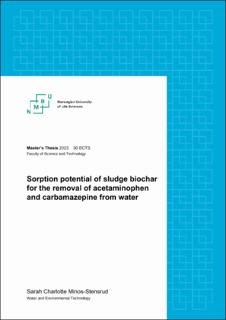| dc.description.abstract | Increasing presence and levels of pharmaceuticals are detected in water bodies, along with growing concern about their impact on aquatic and human life. Currently, different water treatment studies focus on removing contaminants from water, and sorption has become an effective strategy for removing emerging contaminants. Carbonaceous products like activated carbon (AC) and biochar are prominent sorbents, due to their effective adsorption properties. Studies on the potential of biochar, in particular sewage sludge biochar (SBC), as an alternative to activated carbon, have sparked great interest among scientists and industries to develop a sustainable, low-cost, and environmentally friendly sorbent.
This thesis investigates the potential of sewage sludge biochar as an adsorbent for the removal of the pharmaceuticals acetaminophen (ACET) and carbamazepine (CBZ) from water. Preliminary experiments were carried out to find the optimal sorbent dose and contact time. Sorption studies were conducted to obtain the maximum adsorption capacity of the pharmaceuticals, comparing sludge biochar to activated carbon.
In the preliminary experiments, the optimal sorbent dose with the highest removal efficiency was found to be 3.3 g/L. The contact time was decided on 7 days, due to time limitations, although CBZ reached equilibrium within 4 days. The sorption study results showed that AC is highly effective in removing pharmaceuticals, and SBC is a promising sorbent.
With a contact time of 7 days, sorbent dose of 3.3 g/L, and initial concentration of 5 mg/L, SBC removed 58% of ACET and 55% of CBZ. In comparison, AC removed 89% of ACET and 82% of CBZ, and proved the most effective of the two sorbents. This can be attributed to the higher surface area, lower particle size, and finer aggregates of AC compared to SBC. However, as SBC is a more sustainable, cost-effective, and environmentally friendly sorbent, it might be a good alternative to AC for the removal of ACET and CBZ. In the sorption study, the maximum adsorption capacity of SBC in removing ACET was obtained at 21.46 mg/g for the concentration range of 5-500 mg/L. | |
